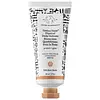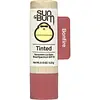What's inside
What's inside
 Key Ingredients
Key Ingredients

 Benefits
Benefits

 Concerns
Concerns

 Ingredients Side-by-side
Ingredients Side-by-side

Water
Skin ConditioningZinc Oxide
Cosmetic ColorantCaprylic/Capric Triglyceride
MaskingDicaprylyl Carbonate
EmollientGlycerin
HumectantPentylene Glycol
Skin ConditioningSteareth-2
EmulsifyingPropanediol
SolventSteareth-21
CleansingPolyhydroxystearic Acid
EmulsifyingCetearyl Alcohol
EmollientSilica
AbrasiveSclerocarya Birrea Seed Oil
HumectantTriethoxycaprylylsilane
Caprylyl Glycol
EmollientCetearyl Glucoside
EmulsifyingSodium Stearoyl Glutamate
CleansingXanthan Gum
EmulsifyingCI 77492
Cosmetic ColorantAloe Barbadensis Leaf Extract
EmollientTocopheryl Acetate
AntioxidantTrisodium Ethylenediamine Disuccinate
CI 77491
Cosmetic ColorantCaprylhydroxamic Acid
Haematococcus Pluvialis Extract
AntioxidantRaspberry Seed Oil/Tocopheryl Succinate Aminopropanediol Esters
Skin ConditioningTetrahexyldecyl Ascorbate
AntioxidantTocopherol
AntioxidantPhenoxyethanol
PreservativeChondrus Crispus Extract
Skin ConditioningSodium C14-16 Olefin Sulfonate
CleansingCI 77499
Cosmetic ColorantGlycine
BufferingSucrose
HumectantAcetyl Glucosamine
Skin ConditioningHelianthus Annuus Sprout Extract
Skin ConditioningHydrolyzed Wheat Protein
Skin ConditioningSimmondsia Chinensis Seed Oil
EmollientHelianthus Annuus Seed Oil
EmollientLecithin
EmollientSea Water
HumectantChlorphenesin
AntimicrobialSodium Dehydroacetate
PreservativeVitis Vinifera Juice Extract
AntioxidantWater, Zinc Oxide, Caprylic/Capric Triglyceride, Dicaprylyl Carbonate, Glycerin, Pentylene Glycol, Steareth-2, Propanediol, Steareth-21, Polyhydroxystearic Acid, Cetearyl Alcohol, Silica, Sclerocarya Birrea Seed Oil, Triethoxycaprylylsilane, Caprylyl Glycol, Cetearyl Glucoside, Sodium Stearoyl Glutamate, Xanthan Gum, CI 77492, Aloe Barbadensis Leaf Extract, Tocopheryl Acetate, Trisodium Ethylenediamine Disuccinate, CI 77491, Caprylhydroxamic Acid, Haematococcus Pluvialis Extract, Raspberry Seed Oil/Tocopheryl Succinate Aminopropanediol Esters, Tetrahexyldecyl Ascorbate, Tocopherol, Phenoxyethanol, Chondrus Crispus Extract, Sodium C14-16 Olefin Sulfonate, CI 77499, Glycine, Sucrose, Acetyl Glucosamine, Helianthus Annuus Sprout Extract, Hydrolyzed Wheat Protein, Simmondsia Chinensis Seed Oil, Helianthus Annuus Seed Oil, Lecithin, Sea Water, Chlorphenesin, Sodium Dehydroacetate, Vitis Vinifera Juice Extract
Homosalate 10%
Skin ConditioningEthylhexyl Salicylate 5%
UV AbsorberOctocrylene 3%
UV AbsorberZinc Oxide 2.85%
Cosmetic ColorantBeeswax
Emulsion StabilisingCocos Nucifera Oil
MaskingButyrospermum Parkii Butter
Skin ConditioningRicinus Communis Seed Oil
MaskingOlea Europaea Fruit Oil
MaskingCaprylic/Capric Triglyceride
MaskingTheobroma Grandiflorum Seed Butter
Skin ConditioningCopernicia Cerifera Wax
Euphorbia Cerifera Wax
Aroma
Mica
Cosmetic ColorantTitanium Dioxide
Cosmetic ColorantCI 75470
Cosmetic ColorantHelianthus Annuus Seed Oil
EmollientOctyldodecyl Oleate
EmollientCI 77492
Cosmetic ColorantLimnanthes Alba Seed Oil
Skin ConditioningAloe Barbadensis Leaf Extract
EmollientSimmondsia Chinensis Seed Oil
EmollientCarthamus Tinctorius Seed Oil
MaskingTocopherol
AntioxidantJojoba Esters
EmollientIndigofera Tinctoria Leaf Extract
Skin ConditioningPolyhydroxystearic Acid
EmulsifyingStevia Rebaudiana Extract
Tin Oxide
AbrasiveSilica
AbrasiveHomosalate 10%, Ethylhexyl Salicylate 5%, Octocrylene 3%, Zinc Oxide 2.85%, Beeswax, Cocos Nucifera Oil, Butyrospermum Parkii Butter, Ricinus Communis Seed Oil, Olea Europaea Fruit Oil, Caprylic/Capric Triglyceride, Theobroma Grandiflorum Seed Butter, Copernicia Cerifera Wax, Euphorbia Cerifera Wax, Aroma, Mica, Titanium Dioxide, CI 75470, Helianthus Annuus Seed Oil, Octyldodecyl Oleate, CI 77492, Limnanthes Alba Seed Oil, Aloe Barbadensis Leaf Extract, Simmondsia Chinensis Seed Oil, Carthamus Tinctorius Seed Oil, Tocopherol, Jojoba Esters, Indigofera Tinctoria Leaf Extract, Polyhydroxystearic Acid, Stevia Rebaudiana Extract, Tin Oxide, Silica
Ingredients Explained
These ingredients are found in both products.
Ingredients higher up in an ingredient list are typically present in a larger amount.
Aloe Barbadensis Leaf Extract is an extract of the leaves of the aloe, Aloe barbadensis, Liliaceae.
Aloe is one of the most well-known natural soothing ingredients, and for good reason. It’s full of water and has a cooling, calming effect on the skin, especially when it’s sunburned, itchy, or irritated. Aloe also helps your skin stay hydrated and smooth by mimicking what healthy skin naturally produces. On top of that, it contains vitamins and nutrients that support skin recovery.
It doesn’t protect you from the sun, but it can help your skin bounce back after too much time in it.
Let’s get into the details:
Aloe contains antioxidant Vitamins A, C, and E, which help fight off free radicals (unstable molecules from things like pollution that can damage your skin).
It’s also rich in polysaccharides, which are natural sugars that help hydrate the skin by acting like the skin’s own moisturizing agents. These, along with other sugars like monosaccharides, help form a protective barrier that locks in moisture.
Aloe works as both a humectant and an emollient. That means it draws water into the skin (humectant) and helps trap it there (emollient), making it an effective natural moisturizer.
You’ll also find a mix of other skin-supporting ingredients in aloe, including folic acid, choline, calcium, amino acids, fatty acids, and even Vitamin B12.
Out of the 420+ species of aloe, Aloe barbadensis is the most widely used in skincare products thanks to its gentle yet effective properties.
There are over 420 species of aloe but Aloe Barbadensis is the most commonly used for topical products.
Learn more about Aloe Barbadensis Leaf ExtractThis ingredient is an emollient, solvent, and texture enhancer. It is considered a skin-softener by helping the skin prevent moisture loss.
It helps thicken a product's formula and makes it easier to spread by dissolving clumping compounds.
Caprylic Triglyceride is made by combining glycerin with coconut oil, forming a clear liquid.
While there is an assumption Caprylic Triglyceride can clog pores due to it being derived from coconut oil, there is no research supporting this.
Learn more about Caprylic/Capric TriglycerideCi 77492 is also hydrated iron III oxide. It's sole purpose is to give a yellow hue to products.
Iron III oxides are classified as inorganic chemicals for coloring.
Synthetically created Ci 77492 is considered safer than those naturally found. This is because the synthetically created version may contain less impurities. Iron oxides are generally non-toxic and non-allergenic.
Learn more about CI 77492Helianthus Annuus Seed Oil is the oil derived from the seeds of a Sunflower. Sunflower seed oil is non-fragrant. It is an emollient, meaning it helps to soften the skin.
Sunflower seed oil contains many fatty acids. The fatty acids found in sunflower seeds include (from highest amount to least): linoleic acid, myristic acid, palmitic acid, stearic acid, arachidic acid, oleic acid, and linolenic acid.
These fatty acids help the skin create ceramides. Ceramides play a role in repairing the skin barrier.
Helianthus Annuus Seed Oil helps moisturize the skin. This in turn helps the skin look more rejuvenated and smoother.
Sunflowers are rich in vitamin E.
Historians believe Indigenous cultures of North America domesticated sunflowers before corn. Thus they relied on sunflower oil for a variety of uses. One such use is moisturizing skin and hair.
Sunflower seed oil may not be fungal acne safe. We recommend speaking with a professional if you have any concerns.
Learn more about Helianthus Annuus Seed OilPolyhydroxystearic Acid is a soft wax made from castor oil.
It is is a texture thickener, emulsifier, and film-former. Emulsifiers prevent ingredients from separating, such as oils and waters.
Polyhydroxystearic Acid may not be fungal acne safe.
Learn more about Polyhydroxystearic AcidSilica, also known as silicon dioxide, is a naturally occurring mineral. It is used as a fine, spherical, and porous powder in cosmetics.
Though it has exfoliant properties, the function of silica varies depending on the product.
The unique structure of silica enhances the spreadability and adds smoothness, making it a great texture enhancer.
It is also used as an active carrier, emulsifier, and mattifier due to its ability to absorb excess oil.
In some products, tiny microneedles called spicules are made from silica or hydrolyzed sponge. When you rub them in, they lightly polish away dead skin layers and enhance the penetration of active ingredients.
Learn more about SilicaThis oil comes from the seeds of the desert shrub called Jojoba. It is more commonly known as jojoba oil, a non-comedogenic oil.
Jojoba oil does not contain fragrance and has many fatty-acids, making it a great soothing ingredient.
It also contains Vitamin E, a great moisturizing ingredient. Vitamin E is also an antioxidant and protects your skin against oxidative damage.
This ingredient humectant properties, meaning it helps draw moisture from the air. This helps keep your skin hydrated.
While jojoba has antibacterial properties, it is only able to kill some strains of bacteria.
Studies also show it helps in wound healing. In fact, Indigenous cultures have used jojoba as a moisturizer and to help treat burns for centuries.
Fun fact: Jojoba oil similar to natural human skin sebum, so it has a great effect on dry skin. It is also promising with helping to regulate sebum production.
Due to its fatty acid content, Jojoba oil may not be fungal acne safe. We recommend speaking with a professional if you have any concerns.
Learn more about Simmondsia Chinensis Seed OilTocopherol (also known as Vitamin E) is a common antioxidant used to help protect the skin from free-radicals and strengthen the skin barrier. It's also fat soluble - this means our skin is great at absorbing it.
Vitamin E also helps keep your natural skin lipids healthy. Your lipid skin barrier naturally consists of lipids, ceramides, and fatty acids. Vitamin E offers extra protection for your skin’s lipid barrier, keeping your skin healthy and nourished.
Another benefit is a bit of UV protection. Vitamin E helps reduce the damage caused by UVB rays. (It should not replace your sunscreen). Combining it with Vitamin C can decrease sunburned cells and hyperpigmentation after UV exposure.
You might have noticed Vitamin E + C often paired together. This is because it is great at stabilizing Vitamin C. Using the two together helps increase the effectiveness of both ingredients.
There are often claims that Vitamin E can reduce/prevent scarring, but these claims haven't been confirmed by scientific research.
Learn more about TocopherolZinc Oxide is a mineral broad-spectrum UV filter; it is the broadest UVA and UVB reflector approved by the FDA. It also has skin protectant and skin soothing properties.
Zinc oxide is one of the most effective broad-spectrum UV filters. It protects against UVB, UVAII, and UVAI. In comparison to its counterpart titanium dioxide, zinc oxide provides uniform and extended UVA protection.
Another great benefit? This ingredient is highly photostable so it won't degrade easily under sunlight.
A common myth is that mineral UV filters are widely believed to primarily reflect UV light.
However, modern research shows titanium dioxide absorbs UV radiation like chemical filters (~95% absorption & 5% reflection).
Zinc oxide has great skin soothing properties so you'll likely find this in sunscreens formulated for sensitive skin or babies/children. It is unlikely to cause "eye sting" like other sunscreen ingredients.
Regulatory agencies consider zinc oxide to be non-toxic and safe. It has also been shown to not penetrate the skin.
Unfortunately, this ingredient does leave a visible white cast. This is why mineral sunscreens are often less cosmetically elegant than chemical or hybrid ones.
In cosmetics, zinc oxide can be found in both non-nano and nano-sized forms. The nano version is used to reduce white cast and improve the texture of sunscreen formulas.
There are ongoing concerns surrounding nano-zinc oxide's impact on marine ecosystems and whether it can be absorbed into skin.
Regarding marine ecosystems and coral reefs, there is no conclusive evidence that any form of zinc oxide (or any other sunscreen ingredients) will cause harm. The science is still developing but many consumers are keeping a close eye on this issue.
Please note, many destinations have reef-safety sunscreen rules. For instance, the U.S. Virgin Islands advises all visitors to use non-nano mineral sunscreens.
There has also been some stir about whether micronized or nano zinc oxide has potential photoxicity and absorption through the skin/lungs.
An in-vitro (done in a test tube or petri dish) study demonstrated micronized zinc oxide to have potential phototoxicity. There's no need to fret; the EU Commission's Scientific Committee on Consumer Safety has stated, "The relevance of these findings needs to be clarified by appropriate investigations in vivo." Or in other words, further studies done on living organisms are needed to prove this.
Current research shows zinc oxide nanoparticles do not penetrate intact or sunburned skin. They either remain on the surface or in the outermost layer of dead skin (stratum corneum).
Zinc oxide is one of only two classified mineral UV filters with titanium dioxide being the other one.
Fun fact: Zinc has been used throughout history as an ingredient in paint and medicine. An Indian text from 500BC is believed to list zinc oxide as a salve for open wound. The Ancient Greek physician Dioscorides has also mentioned the use of zinc as an ointment in 1AD.
Learn more about Zinc Oxide